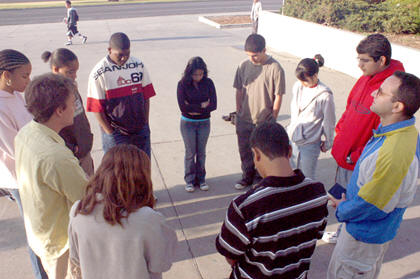Prayer: Can You Do That in School? – Separation of Church and State
It has been said that we all have two things in common: death and taxes. Most Americans share a third commonality—the public schools. Whether or not you have attended public schools or your children have attended, you have paid the taxes to fund them, which makes all of us stakeholders in the public school of America.
The Christian Educators Association, International (CEAI) of which I am Central Florida area director, exists to demonstrate God’s love and truth to the educational community. We equip, empower and encourage educators to reach their God-given potential.
 |
|
| Teens pray at school [Photo by Tom Hanson] | |
|
For those students, parents and teachers who are in the public schools, we would like to offer encouragement to be as wise as serpents and harmless as doves. Being a Christian in a public school is difficult at times, but this article is designed to help Christians realize that much of what we have come to think is unlawful in the public school is not.
For instance, the most frequent concern comes in the form of separation of church and state. Did you know that the term “separation of church and state” does not exist in the U.S. Constitution or Bill of Rights? The first amendment reads: “Congress shall make no law respecting an establishment of religion, or prohibiting the free exercise thereof; or abridging the freedom of speech, or of the press; or the right of the people peaceably to assemble, and to petition the Government for a redress of grievances.”
Two words must be understood: establish and prohibit. We would like to use the synonyms encourage and discourage. When educators are in the public schools, they are wearing their government hats. They cannot establish or encourage religion in the classroom. What most public school administrators and leaders have forgotten is the second clause: or prohibit the free exercise thereof.
In 1962, the Supreme Court disallowed state-sponsored prayer. This Supreme Court decision has been misunderstood over the last four decades. Some have come to believe that the very mention of God’s name is disallowed.
The second word in the First Amendment that needs to be taught is prohibit. Teachers and administrators cannot prohibit or discourage free speech in the public schools. As long as students do not interrupt the instructional time, they do not shed their First Amendment rights at the school house door. Students are allowed to read their Bibles during silent reading periods in class or pray in the halls or over their meals in the cafeteria. They may gather for group prayers such as See You at the Pole or to bless their teachers and administrators.
The school can neither encourage nor discourage the private prayers of individuals. Christians do not have to be ashamed to be Christians in the public schools or lead secretive lives. They must however, be wise and humble as they spread Jesus’ love across their campuses. Shine your light and display your fruits as we prayerfully turn our public school system over to the true Reformer.
Constitutionally protected prayer
On Feb. 7, 2003, then Secretary of Education Rod Paige sent the following letter to U.S. school officials to explain the facts about constitutionally protected prayer in public elementary and secondary schools. For more information, visit the U.S. Department of Education web site at http://www.ed.gov/index.jhtml and type “prayer” in the Search ED.gov box.
Dear Colleague:
As part of the implementation of the No Child Left Behind Act of 2001 (NCLB), I am issuing guidance today on constitutionally protected prayer in public elementary and secondary schools. The purpose of this guidance is to provide State educational agencies (SEAs), local educational agencies (LEAs) and the public with information on this important topic. The guidance also sets forth and explains the responsibilities of SEAs and LEAs with respect to this aspect of the NCLB Act. Most significantly, as a condition of receiving funds under the Elementary and Secondary Education Act (ESEA), an LEA must certify in writing to its SEA that it has no policy that prevents, or otherwise denies participation in, constitutionally protected prayer in public schools as set forth in this guidance.
The guidance clarifies the rights of students to pray in public schools. As stated in the guidance, “…the First Amendment forbids religious activity that is sponsored by the government but protects religious activity that is initiated by private individuals” such as students. Therefore, “[a]mong other things, students may read their Bibles or other scriptures, say grace before meals, and pray or study religious materials with fellow students during recess, the lunch hour, or other noninstructional time to the same extent that they may engage in nonreligious activities.” Public schools should not be hostile to the religious rights of their students and their families.
At the same time, school officials may not “compel students to participate in prayer or other religious activities.” Nor may teachers, school administrators and other school employees, when acting in their official capacities as representatives of the state, encourage or discourage prayer, or participate in such activities with students.
In these challenging times, it is more important than ever to recognize the freedoms we have. I hope that this guidance can contribute to a common understanding of the meaning of the First Amendment in the public school setting. I encourage you to distribute this guidance widely in your community and to discuss its contents and importance with school administrators, teachers, parents, and students.
Sincerely,
Rod Paige,
Secretary of Education
Author: Karen C. Seddon

